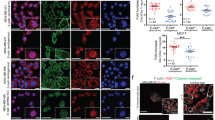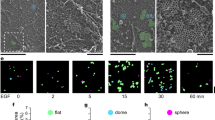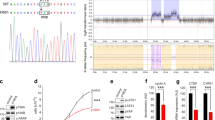Abstract
Cadherin cell–cell adhesion proteins play an important role in modulating the behavior of tumor cells. E-cadherin serves as a suppressor of tumor cell invasion, and when tumor cells turn on the expression of a non-epithelial cadherin, they often express less E-cadherin, enhancing the tumorigenic phenotype of the cells. Here, we show that when A431 cells are forced to express R-cadherin, they dramatically downregulate the expression of endogenous E- and P-cadherin. In addition, we show that this downregulation is owing to increased turnover of the endogenous cadherins via clathrin-dependent endocytosis. p120ctn binds to the juxtamembrane domain of classical cadherins and has been proposed to regulate cadherin adhesive activity. One way p120ctn may accomplish this is to serve as a rheostat to regulate the levels of cadherin. Here, we show that the degradation of E-cadherin in response to expression of R-cadherin is owing to competition for p120ctn.
This is a preview of subscription content, access via your institution
Access options
Subscribe to this journal
Receive 50 print issues and online access
$259.00 per year
only $5.18 per issue
Buy this article
- Purchase on Springer Link
- Instant access to full article PDF
Prices may be subject to local taxes which are calculated during checkout






Similar content being viewed by others
Accession codes
References
Akhtar N, Hotchin NA . (2001). Mol Biol Cell 12: 847–862.
Behrens J . (1999). Cancer Metast Rev 18: 15–30.
Bussemakers MJ, Van Bokhoven A, Tomita K, Jansen CF, Schalken JA . (2000). Int J Cancer 85: 446–450.
Dahl U, Sjodin A, Larue L, Radice GL, Cajander S, Takeichi M et al. (2002). Mol Cell Biol 22: 1474–1487.
Davis MA, Ireton RC, Reynolds AB . (2003). J Cell Biol 163: 525–534.
D'Souza-Schorey C . (2005). Trends Cell Biol 15: 19–26.
Falcone D, Andrews DW . (1991). Mol Cell Biol 11: 2656–2664.
Feltes CM, Kudo A, Blaschuk O, Byers SW . (2002). Cancer Res 62: 6688–6697.
Giroldi LA, Shimazui T, Schalken JA, Yamasaki H, Bringuier PP . (2000). Morphologie 84: 31–38.
Grignani F, Kinsella T, Mencarelli A, Valtieri M, Riganelli D, Lanfrancone L et al. (1998). Cancer Res 58: 14–19.
Guilford P . (1999). Mol Med Today 5: 172–177.
Hazan RB, Kang L, Whooley BP, Borgen PI . (1997). Cell Adhes Commun 4: 399–411.
Hazan RB, Phillips GR, Qiao RF, Norton L, Aaronson SA . (2000). J Cell Biol 148: 779–790.
Ireton RC, Davis MA, van Hengel J, Mariner DJ, Barnes K, Thoreson MA et al. (2002). J Cell Biol 159: 465–476.
Islam S, Carey TE, Wolf GT, Wheelock MJ, Johnson KR . (1996). J Cell Biol 135: 1643–1654.
Islam S, Kim JB, Trendel J, Wheelock MJ, Johnson KR . (2000). J Cell Biochem 78: 141–150.
Johnson E, Theisen CS, Johnson KR, Wheelock MJ . (2004). J Biol Chem 279: 31041–31049.
Johnson KR, Lewis JE, Li D, Wahl J, Soler AP, Knudsen KA et al. (1993). Exp Cell Res 207: 252–260.
Kang Y, Massague J . (2004). Cell 118: 277–279.
Knudsen KA, Wheelock MJ . (1992). J Cell Biol 118: 671–679.
Kowalczyk AP, Reynolds AB . (2004). Curr Opin Cell Biol 16: 522–527.
Laemmli UK . (1970). Nature 227: 680–685.
Le TL, Joseph SR, Yap AS, Stow JL . (2002). Am J Physiol Cell Physiol 283: C489–C499.
Le TL, Yap AS, Stow JL . (1999). J Cell Biol 146: 219–232.
Matsunami H, Miyatani S, Inoue T, Copeland NG, Gilbert DJ, Jenkins NA et al. (1993). J Cell Sci 106 (Part 1): 401–409.
Miranda KC, Joseph SR, Yap AS, Teasdale RD, Stow JL . (2003). J Biol Chem 278: 43480–43488.
Muro S, Wiewrodt R, Thomas A, Koniaris L, Albelda SM, Muzykantov VR et al. (2003). J Cell Sci 116: 1599–1609.
Nieman MT, Kim JB, Johnson KR, Wheelock MJ . (1999a). J Cell Sci 112 (Part 10): 1621–1632.
Nieman MT, Prudoff RS, Johnson KR, Wheelock MJ . (1999b). J Cell Biol 147: 631–644.
Ohkubo T, Ozawa M . (2004). J Cell Sci 117: 1675–1685.
Palacios F, Price L, Schweitzer J, Collard JG, D'Souza-Schorey C . (2001). EMBO J 20: 4973–4986.
Palacios F, Tushir JS, Fujita Y, D'Souza-Schorey C . (2005). Mol Cell Biol 25: 389–402.
Paterson AD, Parton RG, Ferguson C, Stow JL, Yap AS . (2003). J Biol Chem 278: 21050–21057.
Peifer M, Yap AS . (2003). J Cell Biol 163: 437–440.
Pishvaian MJ, Feltes CM, Thompson P, Bussemakers MJ, Schalken JA, Byers SW . (1999). Cancer Res 59: 947–952.
Reynolds AB, Roczniak-Ferguson A . (2004). Oncogene 23: 7947–7956.
Sacco PA, McGranahan TM, Wheelock MJ, Johnson KR . (1995). J Biol Chem 270: 20201–20206.
Subtil A, Hemar A, Dautry-Varsat A . (1994). J Cell Sci 107 (Part 12): 3461–3468.
Suyama K, Shapiro I, Guttman M, Hazan RB . (2002). Cancer Cell 2: 301–314.
Thiery JP . (2002). Nat Rev Cancer 2: 442–454.
Thoreson MA, Anastasiadis PZ, Daniel JM, Ireton RC, Wheelock MJ, Johnson KR et al. (2000). J Cell Biol 148: 189–202.
Tomita K, van Bokhoven A, van Leenders GJ, Ruijter ET, Jansen CF, Bussemakers MJ et al. (2000). Cancer Res 60: 3650–3654.
Vernon AE, LaBonne C . (2004). Curr Biol 14: R719–R721.
Wahl III JK, Kim YJ, Cullen JM, Johnson KR, Wheelock MJ . (2003). J Biol Chem 278: 17269–17276.
Wheelock MJ, Johnson KR . (2003). Annu Rev Cell Dev Biol 19: 207–235.
Wheelock MJ, Buck CA, Bechtol KB, Damsky CH . (1987). J Cell Biochem 34: 187–202.
Wheelock MJ, Soler AP, Knudsen KA . (2001). J Mammary Gland Biol Neoplasia 6: 275–285.
Xiao K, Allison DF, Buckley KM, Kottke MD, Vincent PA, Faundez V et al. (2003a). J Cell Biol 163: 535–545.
Xiao K, Allison DF, Kottke MD, Summers S, Sorescu GP, Faundez V et al. (2003b). J Biol Chem 278: 19199–19208.
Xiao K, Garner J, Buckley KM, Vincent PA, Chiasson CM, Dejana E et al. (2005). Mol Biol Cell 16: 5141–5151.
Acknowledgements
We thank Drs Masatoshi Takeichi and Kathleen Green for antibodies and Dr Takeichi for the R-cadherin cDNA. This work was supported by R01-DE12308, R01-GM51188 and P20-RR018759 from the NIH, by 0460001z from American Heart Association (to SC) and by National Cancer Institute Cancer Center Support Grant P30 CA36727 (to the Eppley Institute). MM was supported by a postdoctoral fellowship from the Eppley Breast Cancer Training Program (DAMD 17-00-1-0361) from the Department of Defense and by a research fellowship from the Uehara Memorial Foundation. KRL was supported by NIH training grant T32 CA09746 (to the Eppley Institute). SAK was supported by a Widaman fellowship from University of Nebraska Medical Center.
Author information
Authors and Affiliations
Corresponding author
Rights and permissions
About this article
Cite this article
Maeda, M., Johnson, E., Mandal, S. et al. Expression of inappropriate cadherins by epithelial tumor cells promotes endocytosis and degradation of E-cadherin via competition for p120ctn. Oncogene 25, 4595–4604 (2006). https://doi.org/10.1038/sj.onc.1209396
Received:
Revised:
Accepted:
Published:
Issue Date:
DOI: https://doi.org/10.1038/sj.onc.1209396
Keywords
This article is cited by
-
Cadherin switches during epithelial-mesenchymal transition: CDH4/RCAD downregulation reduces bladder cancer progression
Cellular Oncology (2022)
-
Kinetic Measurements Reveal Enhanced Protein-Protein Interactions at Intercellular Junctions
Scientific Reports (2016)
-
A cadherin switch underlies malignancy in high-grade gliomas
Oncogene (2015)
-
KLF8 promotes human breast cancer cell invasion and metastasis by transcriptional activation of MMP9
Oncogene (2011)
-
Signaling mechanism of cell adhesion molecules in breast cancer metastasis: potential therapeutic targets
Breast Cancer Research and Treatment (2011)



